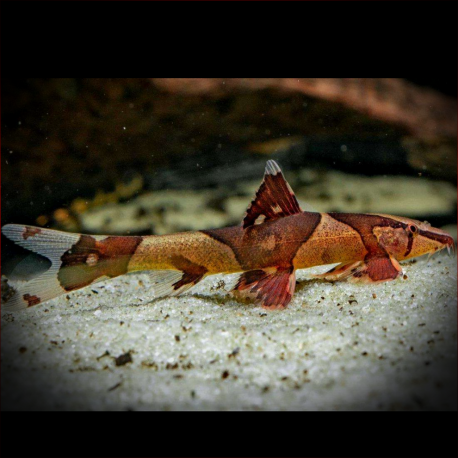More info
Datasheet
| Minimum Tank Size | 160 litres / 42.27 US gallons |
| Maximum Size | 8.0cm / 3.15inches |
| Temperature | 20°C / 68.00°F - 25.5°C / 77.90°F |
| Hardness | 1.01dgH / 18ppm - 10.03dgH / 179ppm |
| pH | 6.0-7.5 |
General Description
Homaloptera parclitella, previously considered a form of H. orthogoniata, exhibits unique characteristics, with distinctive saddle-shaped markings on its body, differentiating it from congeners. Belonging to the Balitoridae family, these "lizard" loaches have specialized morphology for life in fast-flowing waters, with flattened bodies and horizontally extended paired fins aiding in clinging to solid surfaces.
Aquarium Setup
To house H. parclitella, a well-oxygenated tank of at least 160 litres with clean water and a turnover rate of 10-15 times per hour is recommended. Utilize gravel, sand, rocks, and driftwood in the setup, adding elements like aquatic plants and driftwood for enrichment. Stabilizing water conditions and promoting biofilm growth is essential, while a secure cover is needed to prevent escape, given the species' climbing ability.
Behaviour
Known for its non-aggressive nature, H. parclitella thrives in groups of six or more to showcase its best behavior. In the aquarium, these loaches display interesting interactions, often arranging themselves facing the water flow, particularly at certain times of the day.
Feeding and Diet
Specialized grazers, H. parclitella feed on biofilm, crustaceans, and invertebrates. While they may accept sinking dried foods, a diet rich in live or frozen options like Daphnia and bloodworms is vital for their health. Maintaining a tank with algae growth ensures a natural food source for these loaches.
Reproduction & Dimorphism
There is limited information on the reproduction of H. parclitella, with no recorded data in aquarium settings. Sexually mature females tend to be slightly larger and fuller-bodied compared to males.
Habitat and Distribution
Inhabiting swiftly-flowing streams with rocky substrates and dense biofilm, H. parclitella is found in various river basins across Peninsular Malaysia and southern Thailand. Occurring in aggregations in nature, these loaches prefer shallower, well-oxygenated zones with minimal aquatic plant presence.

